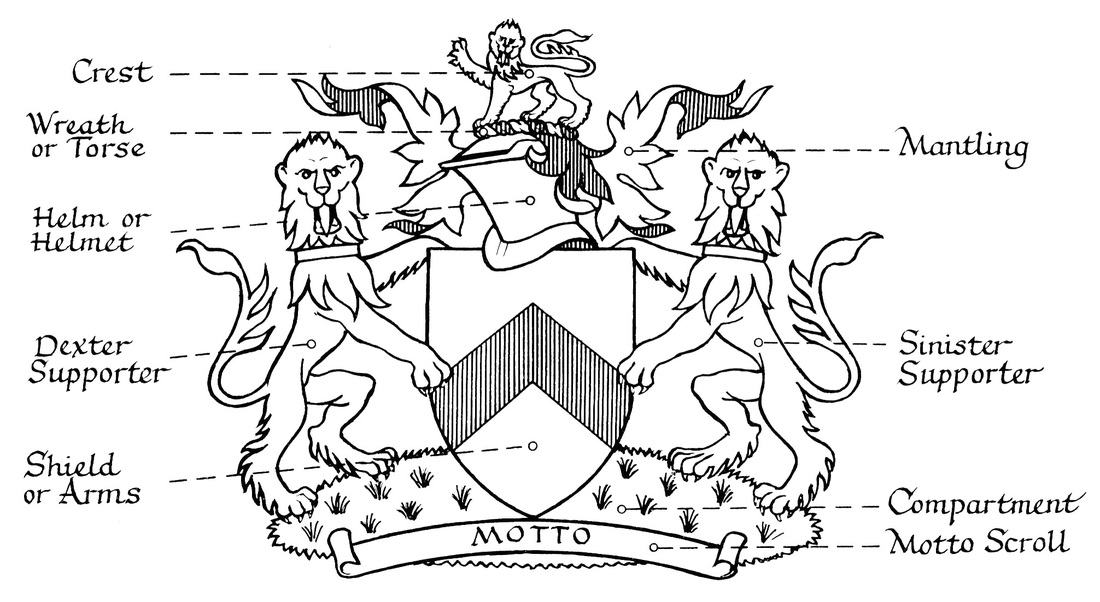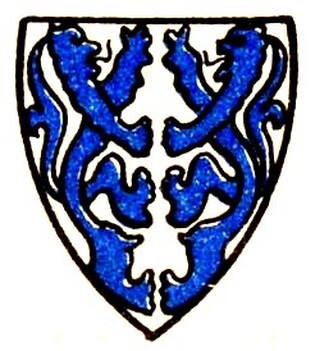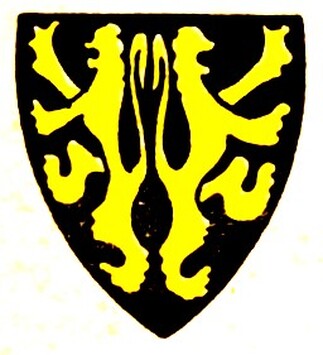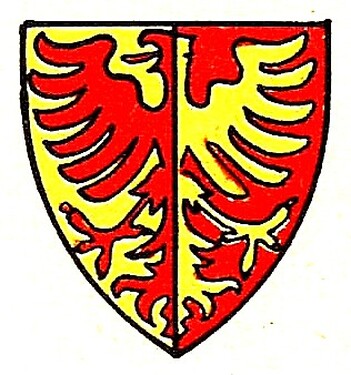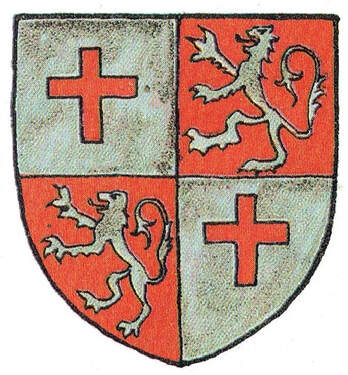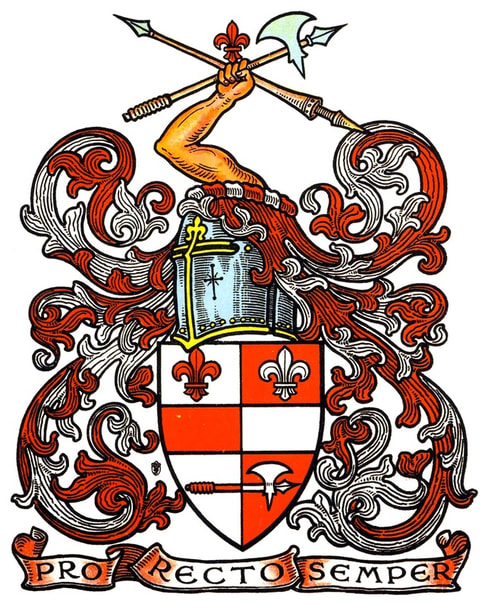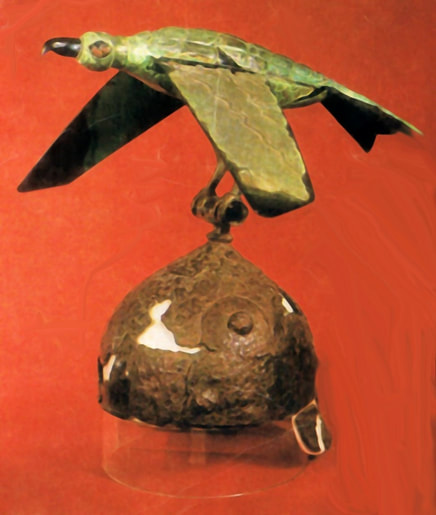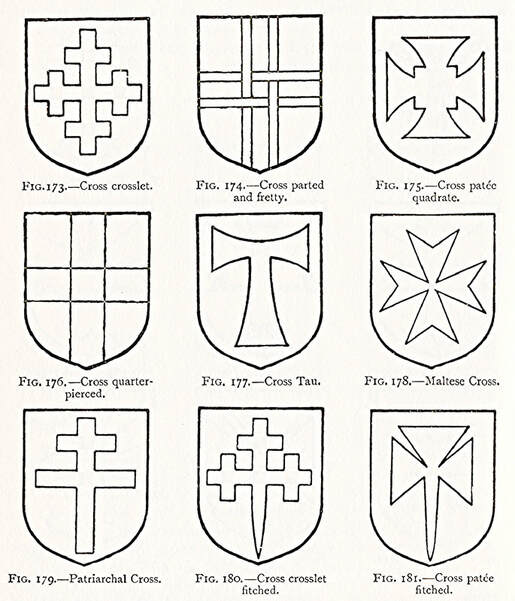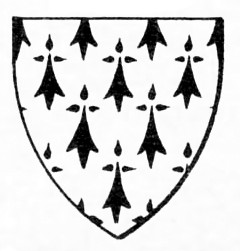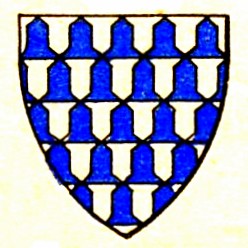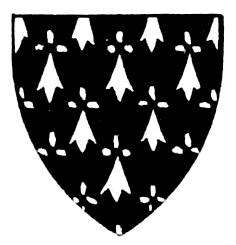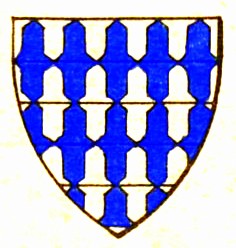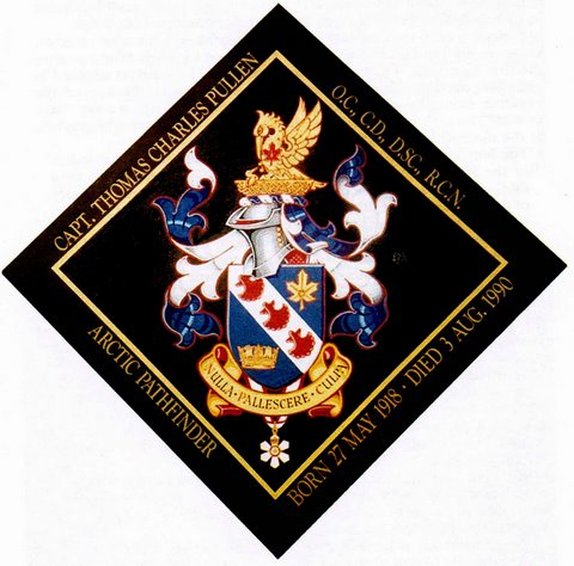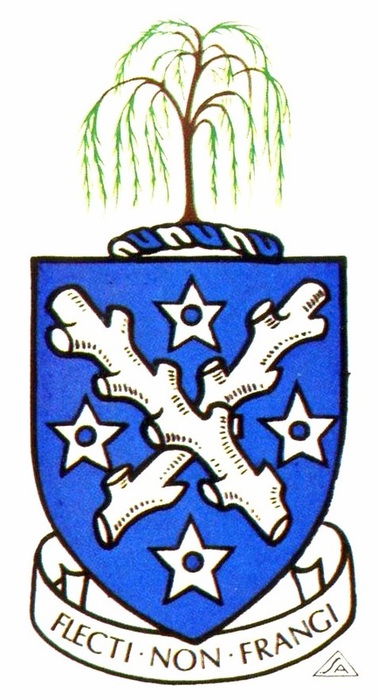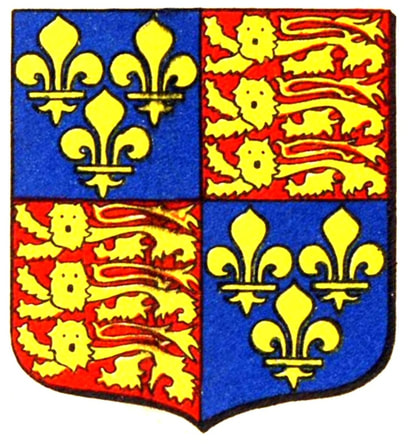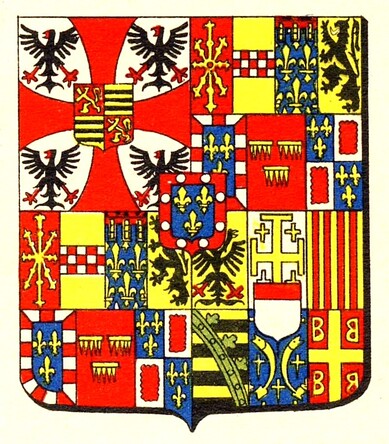GLOSSARY
Introductory Note
The object of this selective glossary is to help readers understand the heraldic terms found in A Guide to Heraldry from a Canadian Perspective. I have attempted to give each term a simple and clear definition while pointing out some overlaps in meaning among such words as arms, achievement of arms and coat of arms. A few illustrations shed light on the significance of certain words or add an historical dimension to their origin. For some more complex words, a link to the Public Register of Arms, Flag and Badges of the Canadian Heraldic Authority is added to provide concrete examples. All the sites given in reference were consulted on 26 July 2020.
Auguste Vachon
The object of this selective glossary is to help readers understand the heraldic terms found in A Guide to Heraldry from a Canadian Perspective. I have attempted to give each term a simple and clear definition while pointing out some overlaps in meaning among such words as arms, achievement of arms and coat of arms. A few illustrations shed light on the significance of certain words or add an historical dimension to their origin. For some more complex words, a link to the Public Register of Arms, Flag and Badges of the Canadian Heraldic Authority is added to provide concrete examples. All the sites given in reference were consulted on 26 July 2020.
Auguste Vachon
♦♦♦
Achievement, achievement of arms – Generally refers to a complete coat of arms, which may include in addition to the shield: a helmet (or helm) placed above the shield, mantling (or lambrequins) flowing from the top of the helmet on both sides and held in place by a wreath (or torse), a crest on top of the helmet rising from the wreath, a motto on a scroll below the shield, and supporters on both sides of the shield standing on a compartment.
1. Components of a full achievement of arms, from Beddoe’s Canadian Heraldry (1981), p. 30
Addorsed – Placed back to back (image 3). The raised wings of birds are often addorsed. Example: https://reg.gg.ca/heraldry/pub-reg/project.asp?lang=e&ProjectID=2625&ShowAll=1.
Affronty – The whole body facing the observer. Example: https://reg.gg.ca/heraldry/pub-reg/project.asp?lang=e&ProjectID=536&ShowAll=1.
Argent – Silver or white.
Armiger – One entitled to bear arms.
Arms – The tinctures and shapes on the shield which is derived from the actual shield worn by knights in battle. The word arms is also used as a short form for a full achievement of arms (image 1).
Azure - Blue.
Affronty – The whole body facing the observer. Example: https://reg.gg.ca/heraldry/pub-reg/project.asp?lang=e&ProjectID=536&ShowAll=1.
Argent – Silver or white.
Armiger – One entitled to bear arms.
Arms – The tinctures and shapes on the shield which is derived from the actual shield worn by knights in battle. The word arms is also used as a short form for a full achievement of arms (image 1).
Azure - Blue.
Badge – The heraldic badge is not part of the coat of arms, but often arranges some of its components in a simplified form. The military badge is an autonomous entity. Compare https://reg.gg.ca/heraldry/pub-reg/project.asp?lang=e&ProjectID=311&ShowAll=1 and https://reg.gg.ca/heraldry/pub-reg/project.asp?lang=e&ProjectID=986&ShowAll=1.
Banner, banner of the arms – In heraldic language, a flag reproducing in a rectangular shape, often a square, the content of the shield.
Bend – A band from top left to lower right of the shield. Per bend: the diagonal division of the shield by a line oriented as a bend. Bendy: a field divided into bends and alternating a metal with a colour.
Bend sinister – A band from the top right to the lower left of the shield. Per bend sinister: the diagonal division of the shield by a line oriented as a bend sinister. Bendy sinister: a field divided into bends sinister and alternating a metal with a colour.
Bezant – Gold disc.
Billet – Small rectangle, usually repeated. Billety: strewn (semy) of billets. Example: https://reg.gg.ca/heraldry/pub-reg/project.asp?lang=e&ProjectID=2302&ShowAll=1.
Blazon, blazoning – The description of arms in heraldic language. Blazonry: The art of describing or painting armorial devices.
Bordure – A band around the edge of the shield, a border. See: images 16-18; https://reg.gg.ca/heraldry/pub-reg/project.asp?lang=e&ProjectID=1833&ShowAll=1
Banner, banner of the arms – In heraldic language, a flag reproducing in a rectangular shape, often a square, the content of the shield.
Bend – A band from top left to lower right of the shield. Per bend: the diagonal division of the shield by a line oriented as a bend. Bendy: a field divided into bends and alternating a metal with a colour.
Bend sinister – A band from the top right to the lower left of the shield. Per bend sinister: the diagonal division of the shield by a line oriented as a bend sinister. Bendy sinister: a field divided into bends sinister and alternating a metal with a colour.
Bezant – Gold disc.
Billet – Small rectangle, usually repeated. Billety: strewn (semy) of billets. Example: https://reg.gg.ca/heraldry/pub-reg/project.asp?lang=e&ProjectID=2302&ShowAll=1.
Blazon, blazoning – The description of arms in heraldic language. Blazonry: The art of describing or painting armorial devices.
Bordure – A band around the edge of the shield, a border. See: images 16-18; https://reg.gg.ca/heraldry/pub-reg/project.asp?lang=e&ProjectID=1833&ShowAll=1
Cadency – Marks on a shield or modifications in content to denote younger members of a family, family branches and descent. Example: https://reg.gg.ca/heraldry/pub-reg/project.asp?lang=e&ProjectID=1274&ShowAll=1.
Charge – Anything on a shield or on a figure within the shield. The shield or figure is said to be charged with what is on it, for instance a cross, a sun, a boar, a tulip, etc.
Chevron – A figure shaped as an inverted V, pointing upwards as the rafters of a roof. Per chevron: division of the shield by a chevron-shaped line. Chevronny: shield covered with chevrons alternating a metal with a colour.
Chief – Horizontal band across the top of the shield.
Coat of arms – Originally referred to the shield and content. Is now widely used as a general term denoting arms or an achievement of arms (image 1). The term is derived from the coat of cloth that knights wore over their armour or coat of mail and which displayed their arms as on their shield.
Colours – The main heraldic colours are Azure (blue), Gules (red), Sable (black), Vert (green), and Purpure (purple). The term “proper” denotes natural colours. See also “metals”. Of the colours means of the main colour and metal on the shield.
Combattant – Two beasts rampant facing one another (image 2). See also addorsed (image 3).
Charge – Anything on a shield or on a figure within the shield. The shield or figure is said to be charged with what is on it, for instance a cross, a sun, a boar, a tulip, etc.
Chevron – A figure shaped as an inverted V, pointing upwards as the rafters of a roof. Per chevron: division of the shield by a chevron-shaped line. Chevronny: shield covered with chevrons alternating a metal with a colour.
Chief – Horizontal band across the top of the shield.
Coat of arms – Originally referred to the shield and content. Is now widely used as a general term denoting arms or an achievement of arms (image 1). The term is derived from the coat of cloth that knights wore over their armour or coat of mail and which displayed their arms as on their shield.
Colours – The main heraldic colours are Azure (blue), Gules (red), Sable (black), Vert (green), and Purpure (purple). The term “proper” denotes natural colours. See also “metals”. Of the colours means of the main colour and metal on the shield.
Combattant – Two beasts rampant facing one another (image 2). See also addorsed (image 3).
Compartment – A mound or base on which the supporters stand (image 1).
Coronet – A small crown placed above the shield to indicate rank. An ornamental or symbolic crown sometimes denoting an affiliation, usually found in the crest or badge. Example: https://reg.gg.ca/heraldry/pub-reg/project.asp?lang=e&ProjectID=1030&ShowAll =1.
Counterchanged – Applies to figures placed on the partition line of a shield divided into a metal and colour. The figures bear the tinctures of the field opposite. The divided eagle (image 4) is Gules (red) on Or (gold, yellow) and Or on Gules. Also applies to figures placed on the colour and metal of a divided field. The figure on the metal takes on the colour of the field opposite and the figure on the colour takes on the metal of the field opposite. The crosses are Gules (red) on Argent (silver, white,) and the lions Argent on Gules (image 5). Some counterchanged situations are complex (image 6).
Coronet – A small crown placed above the shield to indicate rank. An ornamental or symbolic crown sometimes denoting an affiliation, usually found in the crest or badge. Example: https://reg.gg.ca/heraldry/pub-reg/project.asp?lang=e&ProjectID=1030&ShowAll =1.
Counterchanged – Applies to figures placed on the partition line of a shield divided into a metal and colour. The figures bear the tinctures of the field opposite. The divided eagle (image 4) is Gules (red) on Or (gold, yellow) and Or on Gules. Also applies to figures placed on the colour and metal of a divided field. The figure on the metal takes on the colour of the field opposite and the figure on the colour takes on the metal of the field opposite. The crosses are Gules (red) on Argent (silver, white,) and the lions Argent on Gules (image 5). Some counterchanged situations are complex (image 6).
6. Everything on the shield is counterchanged
Crest – A figure of wood or boiled leather that the knights wore on top of their helmet for further recognition (images 1, 6, 7, 16, 17). This term is used erroneously to refer to an entire achievement of arms. Sometimes the crest is placed above the shield without a helmet. It is often used alone or accompanied by a scroll and motto as a simple form of identification, for instance on silver, cufflinks, signets, bookplates and letterheads. Displaying the crest alone or only with motto has been criticized by some authors, although it is a common practice sanctioned by usage. The use of the crest precedes by many centuries the appearance of heraldry (image 7).
7. A spectacular fourth century B.C. Celtic helmet with a falcon crest. Iron, bronze and glass, National Museum of Romanian History
Cross – Generally, a vertical band joined to a horizontal one. There are numerous types of crosses appearing in heraldry, of which image 8 represents a small sampling.
8. Plate from Arthur Charles Fox-Davies, A Complete Guide to Heraldry (London: T.C. & E.C. Jack, 1909), p. 130
Dancetty – Is the same as indented, except that the toothed forms are larger. It also applies to ordinaries that take the form of a zigzag of conjoined V’s, one pointing one way, the next the other way. See: https://reg.gg.ca/heraldry/pub-reg/project.asp?lang=e&ProjectID=711&ShowAll=1.
Dexter – The right side of the shield from the point of view of the knight holding it on his arm. The left side of the shield from the spectator’s point of view.
Difference, marks of difference – Various means of making a shield unique by adding small figures or by modifying tinctures or part of content, see “cadency.”
Displayed – Wings spread outwards (image 9).
Dexter – The right side of the shield from the point of view of the knight holding it on his arm. The left side of the shield from the spectator’s point of view.
Difference, marks of difference – Various means of making a shield unique by adding small figures or by modifying tinctures or part of content, see “cadency.”
Displayed – Wings spread outwards (image 9).
9. Eagle displayed
Enfile, enfiled by – Applies to an object going through a pierced one such as a coronet enfiled by a spear. A thread enfiles the eye of a needle. See: https://reg.gg.ca/heraldry/pub-reg/project.asp?lang=e&ProjectID=1977&ShowAll=1.
Ermine – Black tail shapes on a white field, one of the furs (image 10).
Escallop – A scallop shell usually depicted with the fan downwards.
Ermine – Black tail shapes on a white field, one of the furs (image 10).
Escallop – A scallop shell usually depicted with the fan downwards.
Fess – Horizontal band in centre of the shield. Per fess: division of shield in centre by a horizontal line.
Field – Surface of the shield.
Furs – Mostly “ermine” and “vair” and variations thereof (images 10-13).
Field – Surface of the shield.
Furs – Mostly “ermine” and “vair” and variations thereof (images 10-13).
Grand quarter – One of the main quarterings that is itself quartered, see “quarterly.”
Guardant – Head turned towards the spectator (image 14).
Guardant – Head turned towards the spectator (image 14).
14. A lion passant guardant: walking by and looking at the spectator
Gules – Red.
Gyronny – Division of the shield by lines intersecting in centre of the shield to create wedge-like segments alternating a metal with a colour. Example: https://reg.gg.ca/heraldry/pub-reg/project.asp?lang=e&ProjectID=1478&ShowAll=1.
Hatching – A way of indicating tinctures by variously oriented lines, dots for gold and no marks for silver.
Hatchment – Personal arms on a lozenge placed in the home of the deceased and often in a church afterwards (image 15). When the arms of the deceased are impaled with the arms of a spouse, the background on the side of the spouse is white if he or she is still alive, but the entire background is black if both husband and wife are deceased. Using black or white, the hatchment can also illustrate cases where a first spouse is dead and a second one alive.
Hatchment – Personal arms on a lozenge placed in the home of the deceased and often in a church afterwards (image 15). When the arms of the deceased are impaled with the arms of a spouse, the background on the side of the spouse is white if he or she is still alive, but the entire background is black if both husband and wife are deceased. Using black or white, the hatchment can also illustrate cases where a first spouse is dead and a second one alive.
15. The hatchment of Capt. Thomas Charles Pullen unveiled at Christ Church Cathedral, Ottawa, during a memorial service in 1991. His wife’s arms are not included as she is not armigerous (does not bear arms). From Heraldry in Canada, September 1992, p. 9.
Helm or helmet – The protective metal head casing that covered the knight’s head. In heraldry, it is usually placed on top of the shield (image 15). In some cases, it appears as a charge on the shield
Hurt – A blue disc.
Hurt – A blue disc.
Impalement, impaling – The placement of two arms side by side on one shield: arms of man and wife; personal arms with those of various offices: arms of dean and university, arms of bishop and diocese, arms of mayor and city, arms of Chief Herald of Canada with personal arms, etc. In the case of arms of office impaling personal arms, the latter are on the sinister side (right of spectator). See: https://reg.gg.ca/heraldry/pub-reg/project.asp?lang=e&ProjectID=2260&ShowAll=1.
Indented – Toothed lines or edges, smaller than “dancetty.” See: https://reg.gg.ca/heraldry/pub-reg/project.asp?lang=e&ProjectID=1476&ShowAll=1.
Indented – Toothed lines or edges, smaller than “dancetty.” See: https://reg.gg.ca/heraldry/pub-reg/project.asp?lang=e&ProjectID=1476&ShowAll=1.
Label – Looks like a bench, usually with three legs. Widely used in Europe and in Canada as the mark of the eldest son, heir to the arms. When the father dies, the eldest son inherits the arms as borne by his father and drops the label. See “cadency,” “difference” and images 16-17.
|
16. At the top of the shield is seen a label which is the mark of the eldest son and heir to the arms of the father. Opposite are the arms without the label denoting that the father is deceased. Some of the shading is different in the two depictions, but they are the same arms. Artwork by Gordon Macpherson.
|
17. The label at the top of the shield has been dropped after the decease of the father. The bordure (border) around the shield remains as a Scottish mark of cadency. Artwork by Gordon Macpherson.
|
Lambrequin – Synonym of “mantling.”
Lozenge – A diamond shaped figure. Lozengy: a field divided into lozenges by intersecting diagonal lines in bend and in bend sinister (see bend and bend sinister). Women’s arms were traditionally depicted on a lozenge rather than a shield, a practice tending to disappear (image 18).
Lozenge – A diamond shaped figure. Lozengy: a field divided into lozenges by intersecting diagonal lines in bend and in bend sinister (see bend and bend sinister). Women’s arms were traditionally depicted on a lozenge rather than a shield, a practice tending to disappear (image 18).
18. Bookplate displaying the arms of a woman on a lozenge. See the arms of her husband, images 16-17. Artwork by Gordon Macpherson.
Mantling – The convoluted drapery flowing from the helmet on both sides of the shield, and said to be derived from a piece of cloth that the knight wore on his helmet as protection from the rays of the sun. The mantling is stylized as if cut and tattered during combat (image 17).
Marshalling – The arrangement of various coats of arms on one shield, mostly by quartering (image 20) or impalement.
Metal – The two heraldic metals are Or (gold or yellow), Argent (silver or white). See also “colours”.
Motto – A short phrase appearing on a scroll below the shield, sometimes above: compare images 15 and 16. In some cases, it is placed on the shield itself, for instance: San Sebastian (Spain), Bologna (Italy).
Marshalling – The arrangement of various coats of arms on one shield, mostly by quartering (image 20) or impalement.
Metal – The two heraldic metals are Or (gold or yellow), Argent (silver or white). See also “colours”.
Motto – A short phrase appearing on a scroll below the shield, sometimes above: compare images 15 and 16. In some cases, it is placed on the shield itself, for instance: San Sebastian (Spain), Bologna (Italy).
Or – Gold or yellow.
Ordinary, honourable ordinary – A basic geometric figure. The main ordinaries are: bend, bend sinister, chevron, chief, cross, fess, pale, pile, and saltire.
Ordinary of arms – A dictionary arranging charges in a systematic order, permitting the bearer of the arms to be identified.
Over all – Applies to a figure placed over several figures and mentioned last. Also applies to a small shield placed over division lines (image 21).
Ordinary, honourable ordinary – A basic geometric figure. The main ordinaries are: bend, bend sinister, chevron, chief, cross, fess, pale, pile, and saltire.
Ordinary of arms – A dictionary arranging charges in a systematic order, permitting the bearer of the arms to be identified.
Over all – Applies to a figure placed over several figures and mentioned last. Also applies to a small shield placed over division lines (image 21).
Pale – A vertical band in centre of the shield. Per pale: division of the shield by a vertical line. The Canadian pale, which first appeared in Canada’s flag, is twice as wide as an ordinary pale.
Pall – A forked Y shaped band on the shield. Per pall: division of the shield in Y form.
Passant – Applies to quadrupeds walking by with right fore-leg raised (image 14).
Pellet – A black disc or ball.
Pennon – Mostly applies to a small triangular flag.
Pierced – Perforated, usually round and showing the field (image 19).
Pall – A forked Y shaped band on the shield. Per pall: division of the shield in Y form.
Passant – Applies to quadrupeds walking by with right fore-leg raised (image 14).
Pellet – A black disc or ball.
Pennon – Mostly applies to a small triangular flag.
Pierced – Perforated, usually round and showing the field (image 19).
19. The four mullets (stars) are pierced with a round hole showing the blue field. Arms of Simon-Georges-Gustave Parent. From Beddoe’s Canadian Heraldry (1981), p. 131.
Pile – A wedge-like figure extending from the top line of the shield and tapering to a point near the bottom of the shield.
Plate – A white disc.
Pomme – A green disc.
Proper – Natural colours.
Pretence, escutcheon of – Applies to a small version of the shield of an heiress or co-heiress that the husband displays in centre of his shield.
Plate – A white disc.
Pomme – A green disc.
Proper – Natural colours.
Pretence, escutcheon of – Applies to a small version of the shield of an heiress or co-heiress that the husband displays in centre of his shield.
Quarterly, quarter(s) – The division of the shield by one vertical and one horizontal line, or by several such lines. Each segment, called a quarter, accommodates one individual coat of arms, often repeated twice (image 20). Quarterings generally represent inherited arms. A main quarter can itself be quartered and is then called a grand quarter (image 21).
Rampant – Applies to a quadruped standing on the left hind leg with the right one raised, the left foreleg lowered and the right one raised (image 22).
22. Lion rampant
Sable – Black.
Saltire – An X-shaped cross. Per saltire: division of the shield in X form.
Scroll – A ribbon-like strip with curling ends bearing the motto (image 19).
Semy or semé – Strewn all over with a repeated figure. Example: https://reg.gg.ca/heraldry/pub-reg/project.asp?lang=e&ProjectID=1828&ShowAll=1.
Sinister – The left side of the shield from the point of view of the knight holding it on his arm. The right side of the shield from the spectator’s point of view.
Supporters – Animals or humans, and sometimes objects, holding the shield on both sides (image 1).
Saltire – An X-shaped cross. Per saltire: division of the shield in X form.
Scroll – A ribbon-like strip with curling ends bearing the motto (image 19).
Semy or semé – Strewn all over with a repeated figure. Example: https://reg.gg.ca/heraldry/pub-reg/project.asp?lang=e&ProjectID=1828&ShowAll=1.
Sinister – The left side of the shield from the point of view of the knight holding it on his arm. The right side of the shield from the spectator’s point of view.
Supporters – Animals or humans, and sometimes objects, holding the shield on both sides (image 1).
Tinctures – Refers to metals, colours and furs (image 10-13).
Torse – see Wreath.
Torteau – A red disc.
Trefoil – A three-lobed figure.
Tricking – The indication of tinctures with abbreviations.
Tinctures – Refers to metals, colours and furs (image 10-13).
Torse – see Wreath.
Torteau – A red disc.
Trefoil – A three-lobed figure.
Tricking – The indication of tinctures with abbreviations.
Vair – Bell shapes on a field or charge, alternately upright and reversed, alternately white and blue, one of the furs (image 12).
Vert – Green.
Vert – Green.
Wavy – Having the shape of waves; applies to a line or to a geometric figure.
Wreath or torse – A circle of differently coloured twisted strands of cloth placed at the juncture of the helm and crest. When the crest is depicted alone or above the shield without a helmet, the wreath frequently takes on the appearance of a sausage, although this can be attenuated by clearly outlining the twists in the strands of cloth. Some letters patent specify that the crest issues from “within” the wreath. In others the crest is described as “on a wreath” or “upon a wreath” (image 6).
Wreath or torse – A circle of differently coloured twisted strands of cloth placed at the juncture of the helm and crest. When the crest is depicted alone or above the shield without a helmet, the wreath frequently takes on the appearance of a sausage, although this can be attenuated by clearly outlining the twists in the strands of cloth. Some letters patent specify that the crest issues from “within” the wreath. In others the crest is described as “on a wreath” or “upon a wreath” (image 6).
